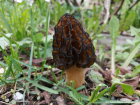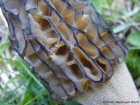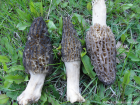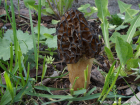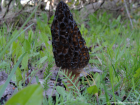Cap is yellowish-brown, with darker parallel longitudinal ribs that are connected to form honeycomb-like pits. The vertical ridges are continuous and for the most part fairly well aligned, while the more randomly spaced horizontal ridges that run between pairs of vertical ridges are noticeably narrower. The flesh is white, brittle, thin and hollow. Stem creamy-white, smooth at the top but usually grooved near the base. It has just one hollow chamber. Spore print pale cream.
Microscopic Features: Spores are ellipsoidal, smooth, measuring 18-25 x 11-15µm, and hyaline, with oil droplets at each end.
Similar species include other Morchella species like Morchella esculenta (Common Morel). Gyromitra species can also be mistaken as Morchella elata but they lack the pitted cap and have a chambered, rather than a hollow, stem. One of these is Gyromitra esculenta (False Morel).
Note: The scientific name Morchella elata was proposed by Elias Magnus Fries from Sweden in 1822. DNA analysis in 2011 has shown North American black morels to be largely distinct from European species, therefore restricting the use of the Morchella elata name to Europe.
Morchella elata on the www.first-nature.com web site.
Morchella elata on Wikipedia.
Many mushrooms are poisonous, and some can be lethally toxic. Distinguishing between edible and poisonous mushrooms can be very challenging. Therefore, we strongly advise against consuming wild mushrooms. This website does not contain any information about the edibility or toxicity of mushrooms.
Although efforts have been made to ensure accuracy on this website, the information may contain errors and omissions. Therefore, all content provided is for educational and informational purposes only and should not be relied upon or used as a basis for consuming any plants or mushrooms.
External links are provided for reference only. We do not endorse or take responsibility for the content, advice, or products found on these sites or in any advertisements shown on this website.
